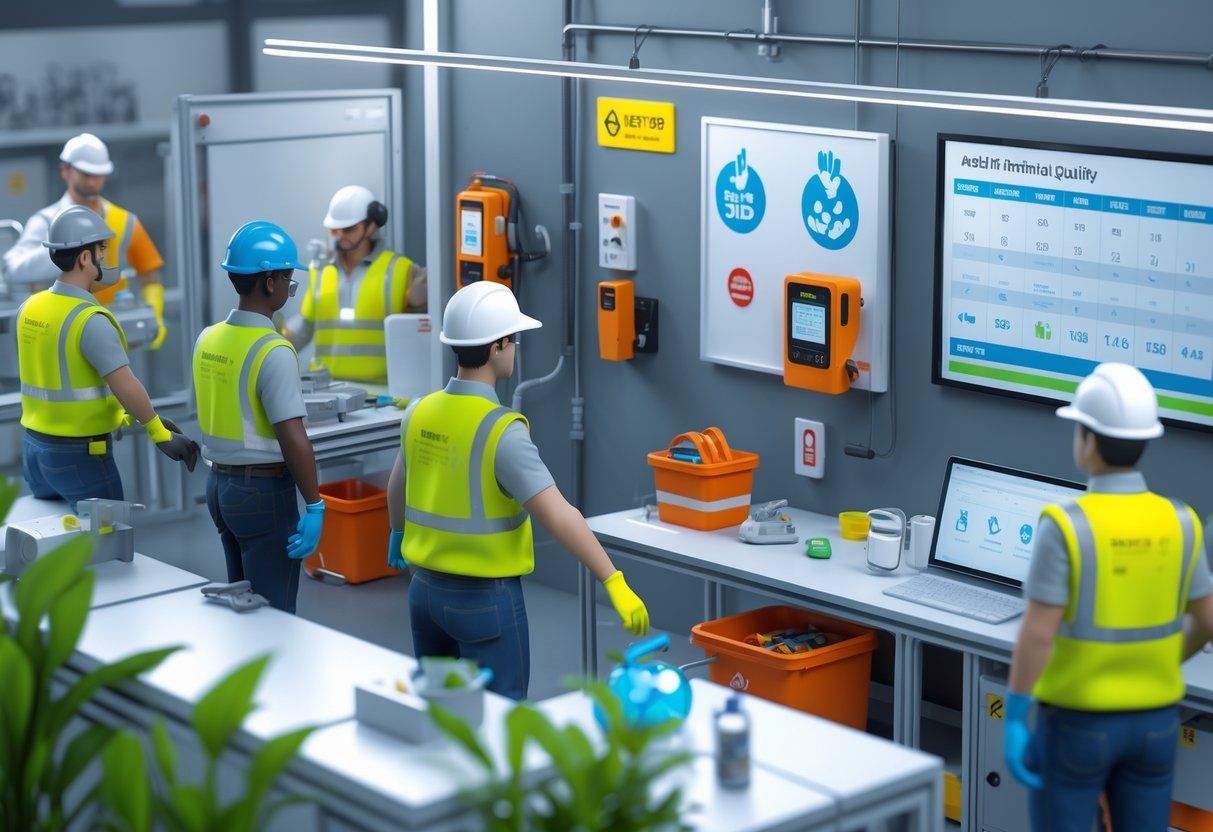Production Quality Standards: Best Practices, Compliance & Key Frameworks
Updated On: November 13, 2025 by Aaron Connolly
Defining Production Quality Standards
Production quality standards lay out clear rules so products line up with what customers expect and actually work. These standards touch on everything—materials, processes, final product performance—and help manufacturers keep things consistent.
What Are Production Quality Standards?
Production quality standards are written guidelines that show us what an acceptable product looks like. They lay out requirements, specs, and traits that products need to hit.
Basically, they’re a rulebook. Like, if football has rules for a goal, quality standards tell us what counts as a “good” product.
Nobody treats these standards as optional. They’re measurable, so we can check if stuff is up to scratch. If we stick to them, customers get products that work and don’t cause problems.
Quality standards do a few big things:
- Set expectations for everyone involved
- Give us a way to measure if we’re succeeding
- Make sure products are safe and dependable
A lot of industries use international standards like ISO 9001. These give companies a shared language about quality, and they make sure a product made in one country will work in another.
Types of Quality Standards
Quality standards fall into a few main categories, each one covering a different angle in production.
Industry-specific standards focus on certain sectors. Food makers have to follow different rules than car manufacturers. Medical device companies? Way stricter than toy makers.
International standards like ISO 9001 work across borders. They help companies do business globally and make sure products meet worldwide expectations. If you export, these are a lifesaver.
Company-specific standards go above and beyond the basics. Some companies set their own higher standards to stand out. These internal rules usually beat industry minimums.
Safety standards are all about keeping users safe. Products like electrical gear or kids’ toys have to pass tough safety tests before they ever hit shelves.
Environmental standards focus on cutting waste and pollution. ISO 14001 helps companies manage their environmental footprint during production.
Elements of a Quality Product
A quality product brings together a few key things that matter to customers.
Performance means the product does what it’s supposed to. A phone should make clear calls. A car should start every time. A washing machine should actually clean your clothes.
Reliability is about the product working the same way every time. People expect it to perform on the first use and the hundredth.
Safety keeps users from getting hurt. Quality products go through a bunch of tests so they won’t cause injury if used the right way.
Durability is how long the product lasts. A quality product should keep doing its job for its whole expected life without falling apart.
Consistency means every product that leaves the factory is up to the same standard. The tenth item off the line should be just as good as the first.
Compliance makes sure products follow all the right rules and regulations. That includes safety certifications, environmental requirements, and industry-specific stuff.
Core International Standards in Production

Factories around the world rely on three main international standards to keep quality and safety in check. ISO 9001 covers quality management systems, and ISO 14001 deals with environmental responsibilities in manufacturing.
Overview of ISO Standards
The International Organisation for Standardisation creates global rules that help manufacturers turn out consistent, high-quality products. These standards act like a blueprint for companies to follow.
ISO standards help with a few key things:
- Define what quality means in manufacturing
- Set up uniform processes in different countries
- Help companies meet legal requirements
- Build customer trust in what they buy
Here are the most important ISO standards for production:
| Standard | Focus Area | Main Purpose |
|---|---|---|
| ISO 9001 | Quality Management | Ensures consistent product quality |
| ISO 14001 | Environmental Impact | Reduces environmental harm |
| ISO 45001 | Health & Safety | Protects worker wellbeing |
Companies that stick to these standards usually see better efficiency and fewer defects. They also find it easier to sell their products in other countries.
Role of ISO 9001
ISO 9001 lays out rules for quality management systems in production. This standard helps companies build processes that deliver the same quality every time.
It covers seven main areas:
- Customer focus and satisfaction
- Leadership commitment to quality
- Employee involvement in quality processes
- Process-based approach to manufacturing
- Continuous improvement methods
- Evidence-based decision making
- Supplier relationship management
ISO 9001 brings a few big benefits:
- Fewer product defects and returns
- Higher customer satisfaction
- Better internal processes
- Easier entry into global markets
Most manufacturers need ISO 9001 certification to compete internationally. Audits and regular reviews make sure companies keep up with the standards.
Companies often see 15-20% fewer quality issues after they start using ISO 9001. That means cost savings and happier customers.
Importance of ISO 14001 Environmental
ISO 14001 environmental standards help factories shrink their environmental impact. This standard’s become pretty much essential as customers and governments push for greener manufacturing.
The standard asks companies to:
- Monitor their environmental impact
- Set targets for cutting waste and emissions
- Train staff on environmental practices
- Regularly review and improve environmental performance
Environmental benefits:
- Lower energy use
- Less waste produced
- Smarter water management
- Fewer carbon emissions
A lot of big retailers now want their suppliers to have ISO 14001 certification. Companies without it often lose out on contracts.
Certification also helps manufacturers save money by cutting energy costs and waste fees. Some companies say they save 10-30% on utilities after adopting ISO 14001.
Accreditation and Certification
Accreditation proves an organisation meets industry standards. Certification shows that specific products or processes follow the right guidelines. Both help esports companies show quality and build trust with partners, sponsors, and players.
ISO Certification Process
ISO certification proves your esports organisation follows international quality standards. It usually takes 3-6 months and costs anywhere from £3,000 to £15,000, depending on company size.
ISO 9001 is all about quality management systems. This helps esports teams and tournament organisers get their processes in order. Sponsors often prefer to work with ISO 9001 certified organisations.
ISO 27001 covers information security. This matters a lot for esports companies that handle player data, payments, and streaming. Tournament platforms often ask for this certification from partners.
Here’s how the certification process usually goes:
- Gap analysis – Compare current practices to ISO requirements
- Documentation – Write up policies and procedures
- Internal audit – Test your new systems before the official review
- Certification audit – An external assessor checks your compliance
- Ongoing surveillance – Yearly check-ins to keep your certification
Most esports organisations start with ISO 9001 before going after specialised standards like ISO 27001.
Auditing and Compliance
Regular audits keep your quality standards working over time. Internal audits happen every six months, and external certification audits take place once a year.
Internal auditing means your own staff check the processes. You should train at least two team members for these reviews. Typical audit areas? Data protection, tournament procedures, player communications.
External audits use independent assessors. They review documentation, talk to staff, and watch operations. You’ll want to set aside 2-3 weeks to get ready.
If you don’t comply, you could lose your certification. Fix audit findings within 30 days to avoid trouble. Keep good records of what you did to fix issues.
Quick tip: Start with simple compliance tracking—just use spreadsheets at first instead of expensive software.
A lot of esports organisations run into trouble with documentation. Focus on key processes first: player contracts, prize payouts, data handling.
Industry-Specific Quality Standards

Different industries need their own quality rules because they face unique risks and challenges. Aerospace companies follow strict safety requirements, manufacturers need environmental certifications, and tech companies have to lock down data protection.
Aerospace Industry Standards
The aerospace industry sticks to some of the toughest quality standards out there. Even tiny mistakes can put lives at risk.
AS9100 is the top quality standard for aerospace. It builds on ISO 9001 but adds extra safety and reliability requirements. Companies have to track every part from start to finish.
The standard covers three big areas:
- Design and development – Every component gets thorough testing
- Risk management – Companies plan for potential problems
- Configuration management – All changes must be documented and approved
Most aerospace suppliers need AS9100 certification to work with big names like Boeing or Airbus. Getting certified takes 6-12 months and costs between £15,000 and £50,000.
RTCA DO-178C covers software for aircraft systems. It has five safety levels, from Level E (no safety impact) up to Level A (catastrophic failure possible).
EMS and Environmental Regulations
Environmental Management Systems (EMS) help manufacturers lower their environmental impact. ISO 14001 is the most popular environmental standard.
Companies with ISO 14001 have to:
- Set environmental goals and track progress
- Reduce waste and energy use
- Follow all local environmental laws
- Train staff on environmental practices
The standard fits any industry, but it’s especially big in manufacturing, chemicals, and energy. Over 300,000 organisations worldwide hold ISO 14001 certification.
EMAS (Eco-Management and Audit Scheme) is stricter than ISO 14001. It makes companies publish detailed environmental reports every year. EMAS is common in Europe but not as much elsewhere.
Energy management standards like ISO 50001 help companies cut energy costs by 10-20%. This standard requires regular energy audits and improvement plans.
Information Security Standards
ISO 27001 is the main standard for keeping company data and customer info safe. It covers both digital and physical security.
The standard includes 114 security controls in 14 categories:
- Access control and user permissions
- Encryption and data protection
- Incident response procedures
- Staff security training
Companies identify their information assets and check security risks. Then they pick which controls to use based on what they need.
ISO 27001 certification usually costs £20,000-£100,000, depending on company size. The process has a gap analysis, implementation phase, and a two-stage audit.
Tech companies, financial services, and healthcare providers often need this certification. Many clients now want suppliers to have ISO 27001 before sharing sensitive data.
The standard requires annual surveillance audits and a full recertification every three years. Companies also need to report security incidents and update risk assessments regularly.
Quality Management Systems (QMS)
Quality management systems set up structured frameworks that help gaming organisations deliver consistent, high-quality esports experiences. These systems focus on continuous improvement and risk management to make sure tournaments, broadcasts, and player experiences meet professional standards.
Fundamentals of Quality Management
A Quality Management System shows how esports organisations document their processes, set quality standards, and measure performance. You can see this in major tournament organisers—they follow strict protocols for everything from match scheduling to broadcast quality.
The core elements include:
- Process documentation – Written procedures for tournament setup, player registration, and technical requirements
- Quality policies – Clear standards for broadcast quality, latency limits, and equipment specs
- Responsibility assignments – Defined roles for technical staff, referees, and production teams
- Performance metrics – Measurable targets for stream uptime, match delays, and viewer satisfaction
Professional esports events like the League of Legends World Championship use comprehensive QMS frameworks. They document every process—from player check-in to post-match interviews.
This system cuts down on errors during live events. It also keeps quality consistent across tournament venues and broadcast locations.
Continuous Improvement in QMS
Continuous improvement pushes esports organisations to constantly evaluate and upgrade their operations. They collect feedback, analyse performance data, and make changes step by step.
Tournament organisers review each event’s performance metrics. They dig into stream quality issues, technical delays, and audience engagement data.
This information shapes how they approach future events.
Key improvement areas include:
- Technical infrastructure – Upgrading servers, improving network stability, reducing latency
- Production quality – Better camera work, improved audio mixing, slicker graphics packages
- Player experience – Faster check-in, better practice facilities, clearer communication
Successful organisations hold post-event reviews with everyone involved. Players, broadcast teams, and technical staff share what worked and what didn’t.
This feedback loop drives real improvements over time. Event organisers track things like average technical delays, stream quality scores, and participant satisfaction to see if changes actually help.
Risk Management in QMS
Risk management in esports quality systems means spotting potential problems before they mess up tournaments or broadcasts. Taking action early can save your reputation and keep players happy.
Common risks include technical failures, player connectivity issues, and broadcast interruptions. Quality management systems set up backup procedures and contingency plans for each scenario.
Critical risk mitigation strategies:
| Risk Area | Mitigation Approach |
|---|---|
| Server crashes | Backup servers, automatic failover systems |
| Internet outages | Multiple ISP connections, mobile network backups |
| Equipment failure | Redundant hardware, on-site technical support |
| Player disputes | Clear rulebooks, trained referees, escalation procedures |
Professional tournaments keep detailed incident response plans. These documents explain exactly who handles each kind of problem and how fast they need to act.
Risk assessment also covers long-term stuff—like rule changes, tech updates, and competitive integrity. Regular audits help spot new risks as the esports scene keeps changing.
Process and Design Quality Standards

Production systems only work well when we use both design quality standards and process quality standards. Design standards focus on what the product should do, while process standards make sure manufacturing methods deliver reliable results.
Design Quality vs Process Quality
Design quality standards lay out what a product must do and how well it should perform. These standards set requirements like strength, size, and function before anyone starts manufacturing.
We use design standards to answer questions like, “How strong should this part be?” or “What temperature does it need to handle?” These requirements guide engineers as they design new products.
Process quality standards focus on how we actually make things. They protect businesses from expensive repairs and wasted products by making sure workers follow the same steps every time.
Process standards cover:
- Temperature controls during production
- Assembly order
- Inspection checkpoints
- Machine calibration schedules
Timing is the key difference. Design quality happens before production. Process quality manages what happens during manufacturing.
Establishing Effective Standards
We need a systematic approach to create solid quality standards for both design and process. First, we figure out what matters most for the product. Then, we build manufacturing processes to match those needs.
Design standard development starts with understanding what customers want and any rules we need to follow. We document performance criteria, material specs, and testing methods.
For process standards, we focus on:
- Control points: Steps that make or break final quality
- Measurement methods: How we check if we’re meeting standards
- Documentation: Clear procedures for employees
- Training requirements: Skills needed to keep standards high
Effective standards must be clear and realistic. Vague goals like “high quality” don’t help anyone. We need exact measurements, tolerances, and acceptance criteria.
Regular reviews keep standards up to date with new tech and customer demands. We update both design and process standards based on production data and feedback.
Regulatory and Compliance Bodies

Key regulatory organisations set the frameworks manufacturers use to meet production quality requirements. NIST provides broad guidelines for quality systems, while IEC and IEEE establish technical standards for electronics.
NIST Guidelines
The National Institute of Standards and Technology (NIST) creates quality management frameworks that manufacturers worldwide turn to. Their Cybersecurity Framework helps companies guard production systems against digital threats.
NIST’s Manufacturing Extension Partnership (MEP) offers practical tips for small and medium manufacturers. Companies use these resources to improve quality control and meet regulations.
Key NIST contributions include:
- Quality management system guidelines
- Measurement standards and calibration procedures
- Risk assessment frameworks
- Manufacturing best practices documentation
NIST works with ISO to align international standards. Their publications help manufacturers understand compliance in different markets.
IEC and IEEE Standards
The International Electrotechnical Commission (IEC) sets safety and performance standards for electrical and electronic products. IEEE develops technical standards that keep products compatible and reliable.
IEC standards cover:
- Electrical safety requirements
- Environmental testing procedures
- Product certification processes
- International compliance guidelines
IEEE focuses on technology standards for electronic components. Their standards matter most for companies making computers, telecom devices, and industrial electronics.
Both organisations team up on new technology standards. Their joint efforts help manufacturers get ready for future regulations.
Supply Chain Considerations
Quality standards really depend on how well we manage suppliers and coordinate the whole supply chain. If suppliers miss the mark, customer satisfaction drops—and the brand takes a hit.
Ensuring Consistency Across Suppliers
Managing quality with multiple suppliers takes clear standards and regular checks. We set up Production Part Approval Processes (PPAP) that lay out design requirements for each supplier.
Key supplier management practices include:
- Setting receiving and inspection schedules based on each supplier’s history
- Using Supplier Corrective Action Requests (SCAR) when things go wrong
- Building centralised supplier rating systems to track performance
- Creating skip-lot sampling processes to catch defects early
We have to qualify all suppliers before they join our approved list. This means checking their quality systems and production abilities.
Regular audits help keep standards on track. Digital tools now let us monitor quality remotely, which is a lifesaver for global supply chains.
Warning: Nearly 96% of manufacturers have had product recalls within five years—usually because of supplier quality failures.
The trick is making suppliers part of our quality management system, not just outsiders.
Impact on Customer Satisfaction
Poor supply chain quality destroys customer trust and costs real money. Product recalls can run into the millions and hurt the brand for years.
Quality problems cause headaches like:
- Delayed shipments when products fail inspection
- Safety issues with faulty goods
- Inconsistent performance from batch to batch
- Higher prices passed on to cover quality control costs
Research shows that managing supply chain quality well can add an average of £156 million to the bottom line by cutting waste and recalls.
Customers expect the same quality every time, no matter which supplier made the product. They don’t care if it was our mistake or the supplier’s—it’s all the same to them.
Modern customers also want sustainability and environmental responsibility from suppliers. So, we have to look at more than just product specs.
Quick win: Get your procurement team involved in quality talks—not just the quality department. They usually know the suppliers best.
Health, Safety and Social Responsibility

Modern production facilities need to balance efficiency with worker wellbeing and their impact on the community. International standards like ISO 45001 help protect employees, while corporate social responsibility programs ensure ethical manufacturing.
ISO 45001 and Worker Safety
ISO 45001 sets the global standard for occupational health and safety management. This standard helps organisations spot workplace hazards before they cause harm.
The framework requires companies to run regular risk assessments. Manufacturers use digital checklists to catch dangers during facility inspections.
Key ISO 45001 requirements include:
- Written health and safety policies
- Employee training programs
- Incident reporting systems
- Emergency response procedures
- Regular performance reviews
Many UK manufacturers say ISO 45001 certification lowers workplace accidents by 30-40%. The standard also helps companies dodge expensive compensation claims and regulatory fines.
Workers get clearer safety rules and better protective gear. Managers use the data to make smart decisions about facility upgrades and training.
Corporate Social Responsibility Standards
Social responsibility in production goes beyond the factory itself—it touches whole communities. Companies now put fair labour practices and environmental protections in place.
Essential CSR elements include:
- Fair wages and working hours
- Supplier codes of conduct
- Environmental impact monitoring
- Community development programs
- Ethical sourcing checks
The ICRC’s QHSE policy shows how organisations audit suppliers for decent working conditions. These checks make sure products meet standards and protect worker rights.
Manufacturers increasingly publish annual sustainability reports. These track progress on carbon reduction, waste management, and social impact.
Consumers want brands that care about worker welfare and the planet. This builds business value while supporting ethical manufacturing.
Technology and Innovation in Quality Standards

Modern manufacturing really leans on technology to keep production quality high. AI systems now spot defects faster than people, and digital transformation brings automated quality checks that run nonstop.
The Role of AI in Production Standards
AI changes the game for quality control by finding problems we’d probably miss. Machine learning algorithms scan thousands of products every minute, catching defects human eyes skip.
Smart cameras powered by AI can pick up scratches, dents, or colour issues in an instant. These systems learn from each inspection and only get better with time.
Predictive maintenance uses AI to stop equipment failures before they happen. Sensors track machine performance and warn operators when it’s time to replace parts. This prevents production hiccups before they become quality disasters.
AI also helps with data analysis across production lines. It spots patterns in defect rates and suggests fixes. If certain batches keep failing, AI can trace it back to a specific machine or shift.
Many manufacturers report 40-60% fewer defective products after adding AI quality systems. But honestly, the tech works best when it supports—rather than replaces—human expertise.
Digital Transformation and Automation
Automated quality systems cut out human error and work around the clock. Robotic inspection stations check products at several stages, making sure standards are met every time.
Digital quality management platforms replace paperwork with real-time data. Quality managers can monitor production from anywhere and get instant alerts if something’s wrong.
IoT sensors across factories gather nonstop data on temperature, pressure, and other key factors. Automated systems use this data to tweak production and keep quality steady.
Digital documentation systems keep all quality records accurate and easy to find. Regulatory compliance is simpler when everything’s digital and properly tracked.
Cloud-based quality platforms let global teams collaborate and keep standards consistent everywhere. Teams can swap best practices and roll out improvements fast, no matter where they are.
Harmonisation and Updates of Standards

Production quality standards always need a refresh to stay relevant. Different regions keep shifting the rules, so we have to adapt, work with international partners, and keep an eye on what actually works.
Adapting to New Regulations
The esports industry sees new regulations pop up all the time. Streaming platforms might suddenly change content requirements, or tournament organisers could tweak player conduct rules.
Gaming hardware manufacturers deal with this constantly. One month, graphics cards have to hit new energy efficiency targets in Germany; the next, keyboards need updated electromagnetic compatibility certifications for the US.
Key regulatory areas include:
- Data protection laws (GDPR in EU)
- Age rating requirements for games
- Broadcasting standards for live streams
- Player safety regulations for extended gaming
Tournament organisers don’t wait around when laws shift. They update player contracts as soon as labour laws change. When tax rules move, they adjust prize distribution right away.
The Anti-Money Laundering (AMS) framework has changed how esports betting and prize money work. Teams now verify player identities with more care. Payment processors ask for extra documentation on international transfers.
International Collaboration
Every country seems to have its own quality standards for gaming equipment. We work with international bodies to build unified standards that everyone can use.
The International Electrotechnical Commission steps in to standardise gaming hardware across borders. So, a gaming mouse certified in the UK ends up working safely in Japan too.
Major collaboration areas:
- Hardware safety certifications
- Game content rating systems
- Tournament broadcasting standards
- Player contract frameworks
Esports organisations don’t keep best practices to themselves. They join international committees, compare how different regions handle player welfare, and align on fair play standards and anti-doping policies.
Cross-border tournaments can get complicated. Prize pools have to follow multiple tax systems. Streaming rights need agreements that work with different copyright laws.
Continuous Review and Improvement
Technology doesn’t sit still, and neither can standards. Gaming hardware gets more powerful every year. Extended gaming sessions bring new health and safety concerns.
We try to review standards at least every 12-18 months. Some areas, like cybersecurity for online tournaments, need quarterly updates.
Review triggers include:
- New technology releases
- Safety incident reports
- Industry feedback surveys
- Regulatory requirement changes
Player feedback really matters. Teams report equipment failures in key matches. Streamers point out audio quality issues that mess with the viewer’s experience.
We collect a lot of data to spot problems. Tournament organisers track how often equipment fails. They see how rule changes impact game fairness and viewer engagement.
Standards committees bring together players, manufacturers, and tournament organisers. This way, updates reflect what’s happening in real life, not just on paper.
Frequently Asked Questions

Companies run into the same kinds of challenges when trying to implement quality standards. Here are some common questions about practical steps, compliance, and the real-world impact of these standards.
What examples can illustrate the application of quality standards in a business context?
Manufacturers often rely on ISO 9001 to create consistent processes for product development. A car manufacturer might use IATF 16949 to make sure every part meets strict safety rules.
Software companies take a slightly different approach. They’ll use frameworks like CMMI to boost their development process and cut down on bugs.
Service businesses benefit too. A logistics company may use ISO 9001 to standardise delivery times and reduce customer complaints by 30%.
Healthcare organisations use quality standards to protect patient safety. Hospitals apply Joint Commission standards to make sure care protocols stay consistent across all departments.
Why are quality standards crucial for maintaining high production levels?
Quality standards help companies stop expensive production failures before they start. Without clear standards, teams waste time fixing mistakes instead of making products.
Consistent quality means less rework and fewer returns. Companies that stick to ISO 9001 often see 10-15% fewer defective products reaching customers.
Teams work more smoothly when everyone follows the same processes. Production flows better, with less confusion and fewer delays.
Customer trust really relies on reliable quality. Companies with certified quality systems usually win more contracts because buyers trust they’ll deliver.
How can I find a comprehensive guide on ISO quality standards for manufacturing?
The International Organization for Standardization publishes official standards at iso.org/standards.html. You can buy standards straight from their site or through national standards bodies.
ISO Technical Committee 176 writes quality management standards like ISO 9001. Their FAQ documents answer common questions and give practical tips.
Manufacturing-specific standards include IATF 16949 for automotive and AS9100 for aerospace. These build on ISO 9001 but add industry-specific requirements.
Training organisations offer certification courses that break down standards in plain English. Look for accredited providers who focus on real-world implementation, not just theory.
Could you provide some common quality standards used in project management?
Project managers often lean on ISO 9001 principles to keep project delivery consistent. The standard helps teams document processes and track project success rates.
PMI’s Project Management Body of Knowledge (PMBOK) makes quality management a core area. It encourages teams to plan quality requirements before work even starts.
Six Sigma methodologies help project teams reduce defects and boost efficiency. Many organisations mix Six Sigma with traditional project management.
Government projects sometimes require specific quality assurance standards. The Uniform Federal Policy for Quality Assurance Project Plans gives public sector teams a structured approach.
What steps should a company take to adhere to international quality standards?
Start by picking the right standard for your industry. ISO 9001 works for most, but automotive or aerospace companies may need sector-specific standards.
Run a gap analysis to spot what your current processes lack. This shows exactly where you need to improve before going for certification.
Train your team on new procedures and document everything clearly. Everyone needs to know their role in keeping quality standards up.
Bring in an accredited certification body to audit your systems. If you meet all the requirements, they’ll issue your certificate.
How do quality standards in various industries impact overall product performance?
Automotive standards like IATF 16949 make vehicles safer and more reliable. When manufacturers stick to these standards, cars usually have fewer recalls. Customers tend to feel more satisfied with their vehicles, too.
Aerospace companies rely on strict standards to keep aircraft components safe. Suppliers who earn AS9100 certification can land contracts with big aircraft manufacturers.
Medical device standards put patient safety first. With ISO 13485, manufacturers keep devices working reliably every time, even across different batches.
Software companies that follow quality standards find and fix more bugs before release. Their products hit the market with way fewer defects—sometimes even 40-50% less.
Food safety standards keep contamination at bay and help food last longer. ISO 22000 guides food makers to deliver steady, trustworthy quality from the farm all the way to your table.

